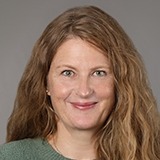Laura Kerosuo, Ph.D.
NIH/NIDCR
Building 30, Room 433
30 Convent Dr. MSC 4340
Bethesda, MD 20892
United States
The neural crest is a transient stem cell population originating right after gastrulation in all developing vertebrate embryos. It gives rise to cell types ranging from melanocytes and peripheral ganglia to cells contributing to the formation of the craniofacial skeleton. About a quarter of human birth defects are neural crest-derived, including craniofacial malformations like cleft palate and cancers like melanoma and neuroblastoma or syndromes like Trecher Collins and DiGeorge syndrome. Little is known about the regulation of stem cell characteristics of these clinically relevant cells. The Kerosuo lab focuses on understanding the molecular mechanisms behind the maintenance of neural crest stemness, how fate choices are made, and whether normal developmental processes apply to neural crest-derived birth defects and cancer. By using a combination of biochemical, cell, and molecular techniques on human embryonic stem cell-derived neural crest cells, together with single-cell and live-imaging in vivo data on chicken and mouse embryos, the Kerosuo lab aims to provide a comprehensive picture of how the neural crest develops as part of the ectoderm patterning process, and to better understand how neural crest-derived diseases arise.
A Peek Inside the Kerosuo Lab
Biographical Sketch
Dr. Laura Kerosuo received her Ph.D. in stem cell biology from the Faculty of Medicine at the University of Helsinki, Finland. She then continued as a postdoctoral fellow at the California Institute of Technology where she initiated her research on stem cell characteristics of the neural crest in the laboratory of Professor Marianne Bronner. Her postdoctoral work demonstrated that neural crest cells, despite their transient nature, maintain a transient stem cell niche of self-renewing cells with a pluripotent gene expression signature located in the dorsal neural tube. Dr. Kerosuo made this discovery by creating novel techniques such as developing crestospheres, an in vitro method to maintain primary neural crest stem cells in a self-renewing state, as well as, in collaboration with biophysicists, developed single cell Multiplex Spatial Transcriptomics Analysis (scMST), which allows transcriptional profiling of segmented cells in their original spatial context in 3D. By studying fate choices during early neural crest specification, she has also proposed a hypothesis for onset of neuroblastoma at a much earlier time point than previously assumed. Based on these findings, Dr. Kerosuo established her lab at NIDCR in July 2018 and continues to pursue research on the molecular mechanisms of early neural crest development and how defects in the process cause disease. The lab has recently discovered novel functions by which the entire ectoderm is maintained in a pluripotent-like state, which challenges the dogma of gastrulation and enables the exceptionally high neural crest stem cell potency to form, as well regulatory details on ectodermal patterning both transcriptionally as well as by post-translational mechanisms.
- Tanjore Ramanathan J, Zárybnický T, Filppu P, Monzo HJ, Monni O, Tervonen TA, Klefström J, Kerosuo L, Kuure S, Laakkonen P. Immunoglobulin superfamily member 3 is required for the vagal neural crest cell migration and enteric neuronal network organization. Sci Rep. 2023 Oct 11;13(1):17162. doi: 10.1038/s41598-023-44093-8.
- Pajanoja C, Hsin J, Olinger B, Schiffmacher A, Yazejian R, Abrams S, Dapkunas A, Zainul Z, Doyle AD, Martin D, Kerosuo L. Maintenance of pluripotency-like signature in the entire ectoderm leads to neural crest stem cell potential. Nat Commun. 2023 Sep 23;14(1):5941. doi: 10.1038/s41467-023-41384-6.
- Asmar AJ, Abrams SR, Hsin J, Collins JC, Yazejian RM, Wu Y, Cho J, Doyle AD, Cinthala S, Simon M, van Jaarsveld RH, Beck DB, Kerosuo L, Werner A. A ubiquitin-based effector-to-inhibitor switch coordinates early brain, craniofacial, and skin development. Nat Commun. 2023 Jul 26;14(1):4499. doi: 10.1038/s41467-023-40223-y.
- Takko H, Pajanoja C, Kurtzeborn K, Hsin J, Kuure S, Kerosuo L. ShapeMetrics: A userfriendly pipeline for 3D cell segmentation and spatial tissue analysis. Dev Biol. 2020 Jun 1;462(1):7-19. doi: 10.1016/j.ydbio.2020.02.003.
- Mohlin S, Kunttas E, Persson CU, Abdel-Haq R, Castillo A, Murko C, Bronner ME, Kerosuo L. Maintaining multipotent trunk neural crest stem cells as self-renewing crestospheres. Dev Biol. 2019 Mar 15;447(2):137-146. doi: 10.1016/j.ydbio.2019.01.010. Epub 2019 Jan 18.
- Kerosuo L, Neppala P, Hsin J, Mohlin S, Vieceli FM, Török Z, Laine A, Westermarck J, Bronner ME. Enhanced expression of MycN/CIP2A drives neural crest toward a neural stem cell-like fate: Implications for priming of neuroblastoma. Proc Natl Acad Sci U S A. 2018 Jul 31;115(31):E7351-E7360. doi: 10.1073/pnas.1800039115. Epub 2018 Jul 18.

